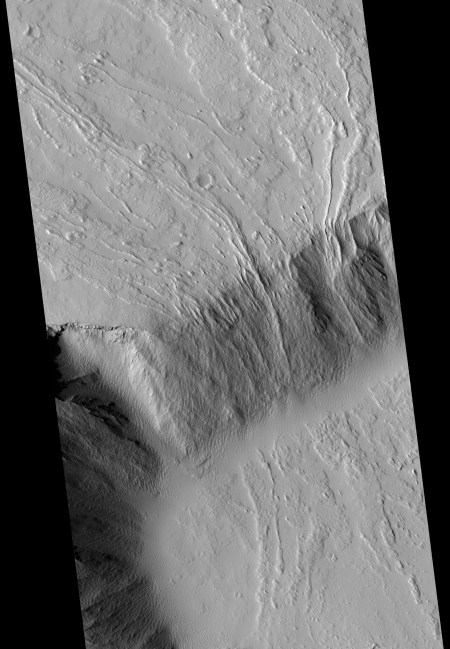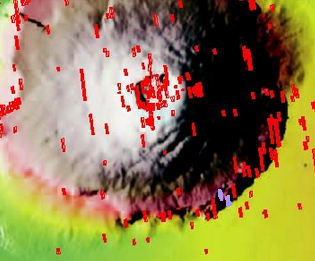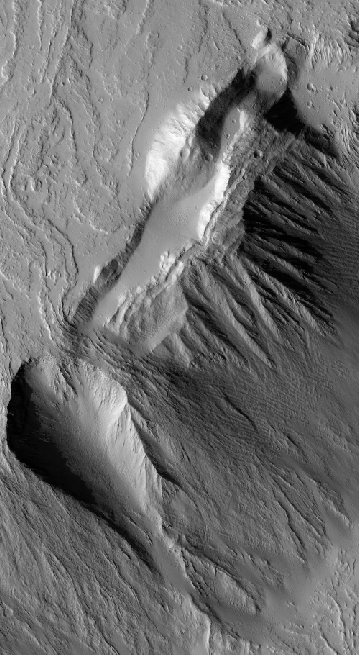The epic lava flows of Olympus Mons

The eruption of Kilauea volcano in Hawaii has garnered a lot of deserved press coverage, having added at least a 200 acres of new land and destroyed at least 700 homes. Similarly, the recent violent eruption of a volcano in Guatemala, killing 100 people in its wake, has also gotten much deserved news coverage.
The magnitude of both however would pale in comparison to the stupendous eruption that occurred several hundred million years ago at the solar system’s largest volcano, Olympus Mons on Mars. While Kilauea is about 100 miles across, Olympus Mons is about 370 miles wide, and is so large that because of the curvature of Mar’s surface it is literally impossible for a viewer on the ground to actually see the volcano, in its entirety.
Both volcanoes are shield volcanoes, however, which means the lava flows don’t necessarily come from the caldera, but often from vents on the volcano’s slopes. Eruptions might be violent, but they generally do not involve the powerful explosive force of the sudden eruption, as seen in Guatemala and at Mount St. Helens in 1980 in the U.S. Instead, the lava seeps out steadily and continuously, an unstoppable flow that steadily overwhelms the surrounding terrain.

The flows that created Olympus Mons however were an epic event probably lasting millions of years, which brings us to this post. In the June release of Mars Reconnaissance Orbiter high resolution images, I found the image above, cropped and reduced in resolution to post here. It shows lava flowing down off one of the many escarpments on the slopes of Olympus Mons. This is not at the edge of the volcano’s shield, but just inside it. The map at the right, created using the archive of MRO’s high resolution camera, indicates the location of this flow, shown by the left light blue rectangle on the southeast slope of the volcano’s shield. The red rectangles show all the other images MRO has taken of Olympus Mons.
The scale of the MRO image above gives an indication of how big that eruption at Olympus Mons was.
The image above shows an area about 750 feet wide by 1,000 feet long, with objects as small as 5 feet visible in the full resolution version. And yet, from the overview image we can see how little territory of the volcano’s shield that blue rectangle covers.

The second blue rectangle to the right on the overview image is another MRO image, cropped by me to post here on the right. This image was taken in August 2016 in about the same scale, and also shows lava flows coming down the slopes. It, like the image above, also shows what appears to be a collapse of some kind on the escarpment, forming an alcove in the escarpment wall. These alcoves could have occurred because the flows from above pushed the escarpment downward, forcing an avalanche. Or the alcoves themselves could have been lava vents from which additional lava flowed.
The second image also shows a depression at the top of the escarpment running parallel to it, now partly filled with a pond of Martian dust. To my eye this suggests that sometime in the past, probably when Olympus Mons was active, the escarpment separated from the slope above in a kind of slow motion avalanche, creating the depression at the top.
Today, Mars’s volcanoes are silent and unmoving. All data presently suggest that they are dormant, and will likely not erupt ever again (though the lander InSight, presently heading to Mars, might change that conclusion).
When they were erupting however the spectacle must have been amazing, breath-taking, and something to be seen. But like Kilauea in Hawaii, if you had wanted to watch, you would have been wise to do it from a considerable distance. Lava is unstoppable, and even slow-moving lava is very dangerous.
And on Mars at Olympus Mons, there had been a lot of it, over a very large area.
On Christmas Eve 1968 three Americans became the first humans to visit another world. What they did to celebrate was unexpected and profound, and will be remembered throughout all human history. Genesis: the Story of Apollo 8, Robert Zimmerman's classic history of humanity's first journey to another world, tells that story, and it is now available as both an ebook and an audiobook, both with a foreword by Valerie Anders and a new introduction by Robert Zimmerman.
The print edition can be purchased at Amazon or from any other book seller. If you want an autographed copy the price is $60 for the hardback and $45 for the paperback, plus $8 shipping for each. Go here for purchasing details. The ebook is available everywhere for $5.99 (before discount) at amazon, or direct from my ebook publisher, ebookit. If you buy it from ebookit you don't support the big tech companies and the author gets a bigger cut much sooner.
The audiobook is also available at all these vendors, and is also free with a 30-day trial membership to Audible.
"Not simply about one mission, [Genesis] is also the history of America's quest for the moon... Zimmerman has done a masterful job of tying disparate events together into a solid account of one of America's greatest human triumphs."--San Antonio Express-News


The scale involved with Olympus Mons is awe inspiring.
One correction, the big eruption of Mt. St. Hellens was on May 18, 1980 (not 1988 as in the text).
TL: Thank you. Typo has been fixed.